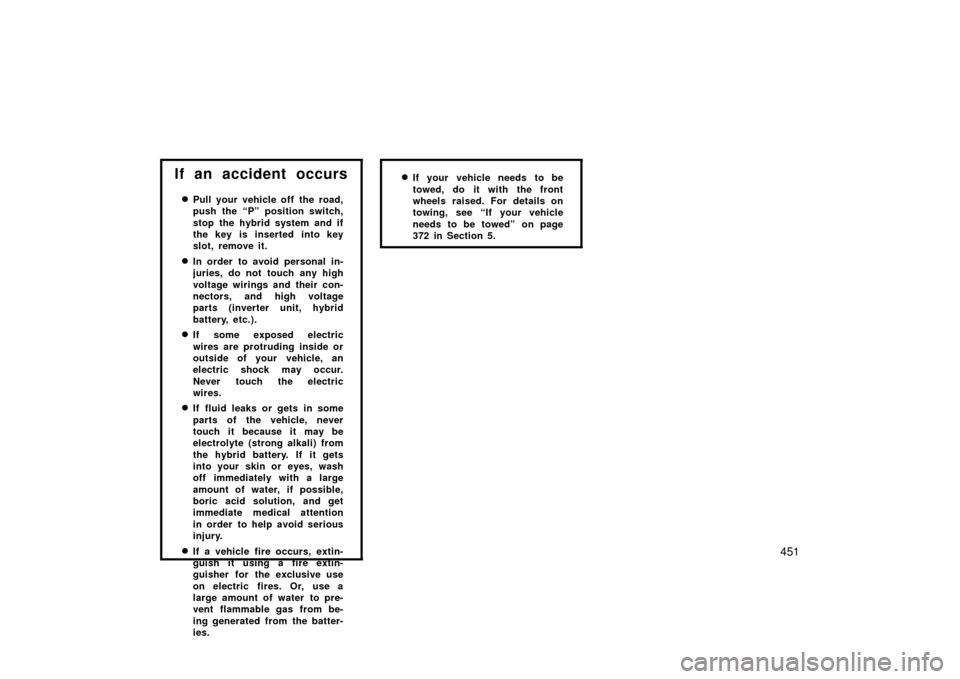Page 412 of 455
412�
When installing aluminum w
heels,
check that the wheel nuts are tight
after driving your vehicle the first 1600
km (1000 miles).
�If you have rotated, repaired, or
changed your tires, check that the
wheel nuts are still tight after driving
1600 km (1000 miles).
�When using tire chains, be careful not
to damage the aluminum wheels.
�Use only Toyota wheel nuts and
wrench designed for your aluminum
wheels.
�When balancing your wheels, use only
Toyota balance weights or equivalent
and a plastic or rubber hammer.
�As with any wheel, periodically check
your aluminum wheels for damage. If
damaged, replace immediately.
Aluminum wheel precautions
Page 426 of 455
426
Overall length mm (in.) 4445 (175.0)
Overall width mm (in.) 1725 (67.9)
Overall height mm (in.) 1490 (58.7)*
Wheelbase mm (in.) 2700 (106.3)
Front tread mm (in.) 1505 (59.3)
Rear tread mm (in.) 1480 (58.3)
Vehicle capacity weight
(occupants + luggage)kg (lb.) 365 (810)
*: Unladen vehicle
Electric motor
Type: Permanent magnet synchronous motor (water cooling)
Maximum output: 50/1200 − 1540 kW/rpm
Maximum torque: 400/0 − 1200 N·m/rpm Model: 1.5 L 4
−cylinder (1NZ− FXE)
Type: 4 −cylinder in line, 4 cycle, gasoline
Bore and stroke, mm (in.): 75.0 x 84.7 (2.95 x 3.33)
Displacement, cm
3 (cu. in.):
1497 (91.4)
Dimensions and weight Engine
Page 429 of 455

429
12 VOLT BATTERY
Open voltage at 20�C (68 �F):
12.6 − 12.8 V Fully charged
12.2 − 12.4 V Half charged
11 . 5 − 11.9 V Discharged
[Voltage that is checked 20 minutes after
the key is removed with all the lights
turned off]
Charging rates: 3.5 A max.
HYBRID TRANSAXLE
Fluid capacity (drain and refill),
L (qt., Imp.qt.): 3.6 (3.8, 3.2)
Fluid type: “Toyota Genuine ATF WS” or
equivalent
Please contact your Toyota dealer for further
details. BRAKES
Minimum pedal clearance when depressed
with the force of 196 N (20 kgf, 44 lbf)
with the traction motor running, mm (in.):
101.0 (3.98)
Pedal free play, mm (in.): 1 − 4 (0.04 − 0.16)
Parking brake adjustment when depressed
with the force of 294 N (30 kgf, 66 lbf): 6 − 9 clicks
Fluid type: SAE J1703 or FMVSS No. 116 DOT 3
STEERING
Wheel free play: Less than 30 mm (1.2 in.)
Tires
Tire size and inflation pressure:
Tire size kPa (kgf/cm
2 or ba r, ps i )
Standard Front
P185/65R15 86S 240 (2. 4, 35)
Rear
P185/65R15 86S 230 (2. 3, 33)
Spare T125/70D16 96M 420 (4. 2, 60)
Wheel size: Standard 15 x 6JJ
S par e 16 x 4T
Wheel nut torque, N·m (kgf·m,
ft·lbf): 103 (10.5, 76)
NOTE: For a complete information on tires (e.g. replacing tires
or replacing wheels), see
“Checking tire inflation pres-
sure” through “Aluminum
wheel precautions”, page
405 through 412.
Page 441 of 455

441
�SRS airbag deployment data
� SRS airbag system diagnostic
data
If your vehicle is equipped with a
vehicle stability control (VSC) sys-
tem, its Electronic Control Unit
(ECU) may contain another EDR.
There are a variety of driving situ-
ations which include activating the
VSC under which the VSC EDR
will record certain information. The
VSC EDR may record some or all
of the following information:
� Behavior of the vehicle
� Steering wheel angle
� Vehicle speed
� To what extent the accelerator
pedal was depressed
� To what extent the brake ped-
al was applied
� To what extent the ECU con-
trolled the condition of the 4
wheels
� Vehicle stability control sys-
tem diagnostic data
The information above is intended
to be used for the purpose of im-
proving vehicle safety perfor-
mance. Unlike general data record-
ers, the EDR does not record
sound data such as conversation
between passengers.Toyota will not disclose the data
recorded in an EDR to a third
party except when:
� An agreement from the ve-
hicle’s owner (or the leasing
company for a leased vehicle)
is obtained
� Officially requested by the po-
lice or other authorities
� Used as a defence for Toyota
in a law suit
� Ordered by the court
However, if necessary Toyota will:
� Use the data for research on
Toyota vehicle safety perfor-
mance
� Disclose the data to a third
party for research purposes
without disclosing details of
the vehicle owner, and only
when it is deemed necessary
� Disclose summarized data
cleared of vehicle identifica-
tion information to a non −To -
yota organization for research
purposes
Page 451 of 455

451
If an accident occurs
�Pull your vehicle off the road,
push the “P” position switch,
stop the hybrid system and if
the key is inserted into key
slot, remove it.
�In order to avoid personal in-
juries, do not touch any high
voltage wirings and their con-
nectors, and high voltage
parts (inverter unit, hybrid
battery, etc.).
�If some exposed electric
wires are protruding inside or
outside of your vehicle, an
electric shock may occur.
Never touch the electric
wires.
�If fluid leaks or gets in some
parts of the vehicle, never
touch it because it may be
electrolyte (strong alkali) from
the hybrid battery. If it gets
into your skin or eyes, wash
off immediately with a large
amount of water, if possible,
boric acid solution, and get
immediate medical attention
in order to help avoid serious
injury.
�If a vehicle fire occurs, extin-
guish it using a fire extin-
guisher for the exclusive use
on electric fires. Or, use a
large amount of water to pre-
vent flammable gas from be-
ing generated from the batter-
ies.
�If your vehicle needs to be
towed, do it with the front
wheels raised. For details on
towing, see “If your vehicle
needs to be towed” on page
372 in Section 5.